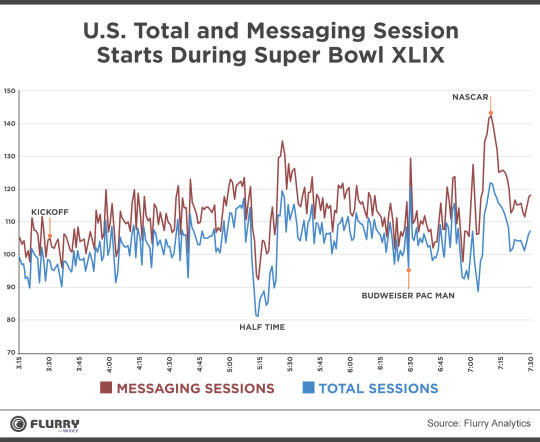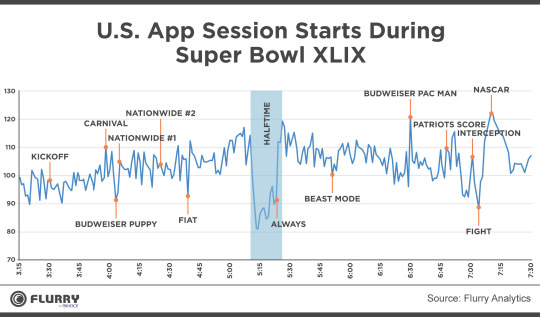February 5, 2015 | Jarah Euston
According to Nielsen, Super Bowl XLIX was the most-watched television event in U.S. history, with an average 114.4 million viewers. Households all over the country had their TVs tuned to the game, and their smartphones in their hands.
As we’ve done in years past, Flurry from Yahoo examined app usage activity during the big game. While the battle between the New England Patriots and the Seattle Seahawks for the Lombardi trophy was a nail-biter to the very end, the clear winner of viewer attention was Katy Perry and her half time extravaganza. When it came to the ad bowl, the Budweiser puppy made us sit up and put down our phones more than any other Super Bowl ad. In this report we examine second-by-second how what was happening on our TVs impacted what we do with the screens in our hands.
For this study, Flurry from Yahoo indexed second-by-second app session starts (as defined by when a user launches an app or brings it to the foreground) from 3:15 p.m. to 7:30 p.m. Pacific time during the big game. We looked at the index for all apps (blue line) and then isolated social Messaging apps (red line). The index is based on the average app session starts of the previous three Sundays in January in order to control for normal app usage fluctuations. In this case a value of 100 means the app activity during the Super Bowl was equal to the average app activity of the previous three Sundays. Flurry Analytics tracks 630,000 apps and sees an average of 7 billion sessions per day worldwide.
Messaging Apps Connected Fans Across the Nation

It’s interesting to note that overall, we were on our phones more during the Super Bowl than an average Sunday (remember, 100 is the baseline average). While most people watch the Super Bowl with others, we are also communicating with folks outside of the room constantly except for key moments. As the chart above shows, apps in the Messaging category had higher activity than apps overall during the game. No longer are we limited to cheering (or crying) with those in the living room, we have a nation full of fans with whom to celebrate (or commiserate).
The jerky nature of our attention during the Super Bowl suggests that when we see something on the screen that grabs our attention, we immediately turn to our devices and apps to discuss what we just saw. A great example of this is the Budweiser Pac Man commercial. At 6:29 p.m. we put our phones down to watch the real-life arcade game, but at 6:30 p.m. picked them right back up. This suggests a big opportunity for advertisers to amplify their message by continuing the campaign within apps. The most striking example of this was Nick Offerman’s NASCAR commercial which ran at 7:10pm, five minutes after the game ended. The chart shows that app activity increased by 20 percent during that spot, while social activity increased by more than 40 percent! App addicts were ready to talk about Offerman and NASCAR after the provocative spot.
Only Half Time and End Zone Brawls Tempered App Activity

As has been the case in years past, half time was when we took a break from apps and actually engage in the content on the TV. Katy Perry’s half time show decreased app activity by about 20% from an average Sunday, but as Missy Elliott took the stage we started to pick up our phones again- either to share our excitement, ask friends “Who is Missy Elliott?” or check in with Candy Crush. While you might expect that following half time would be prime ad placement, app activity spiked during the Always “Like a Girl” commercial as folks took to social apps. Perhaps they were discussing the ad, but we know their eyes were on their small screens. The only other drop in app activity greater than 10 percent happened during the end zone fight with 18 seconds left in the game.
Some of the most talked-about ads in this year’s game came from Nationwide. Its first ad, featuring Mindy Kaling, not only had the benefit of following Budweiser’s lost puppy tear-jerker, but was funny in its own right. Nationwide’s much-maligned second ad, featuring tragic household accidents, didn’t hold our attention- we were on our phones as the graph above shows.
TV and Mobile: A Cross-Device Touchdown for Advertisers?
Advertisers (and content producers for that matter) are still trying to figure out how to manage consumers’ split interest between screens on their walls and screens in their hands. The price of Super Bowl ads continue to climb: This year a 30-second spot ran for as much as $4.5 million. Especially during this annual cornerstone branding opportunity, marketers should be looking for ways to ensure they’re getting the most bang for their buck. Making consumer engagement on the big and small screens a team effort is one way to make sure those marketing dollars work hard into the post-season.